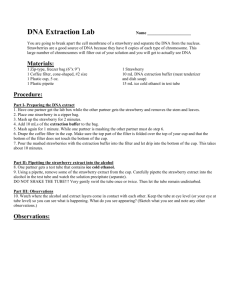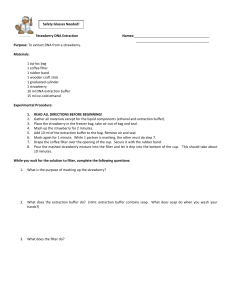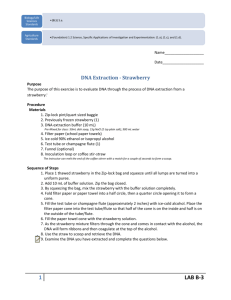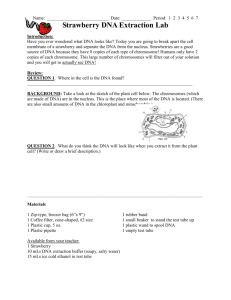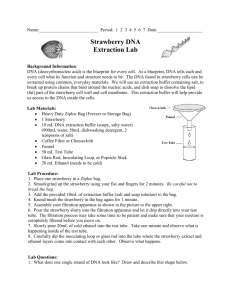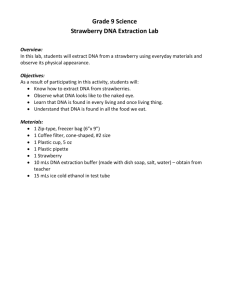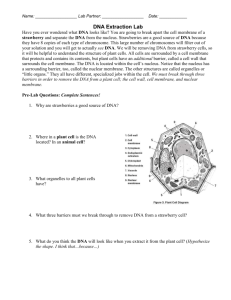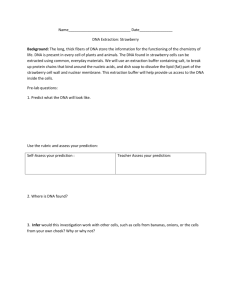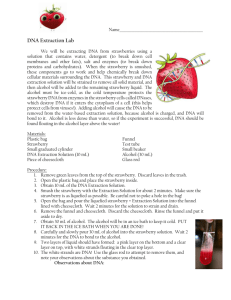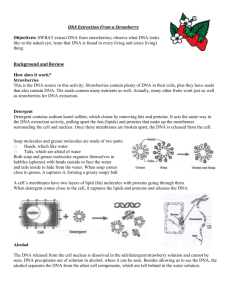Strawberry DNA Extraction
advertisement
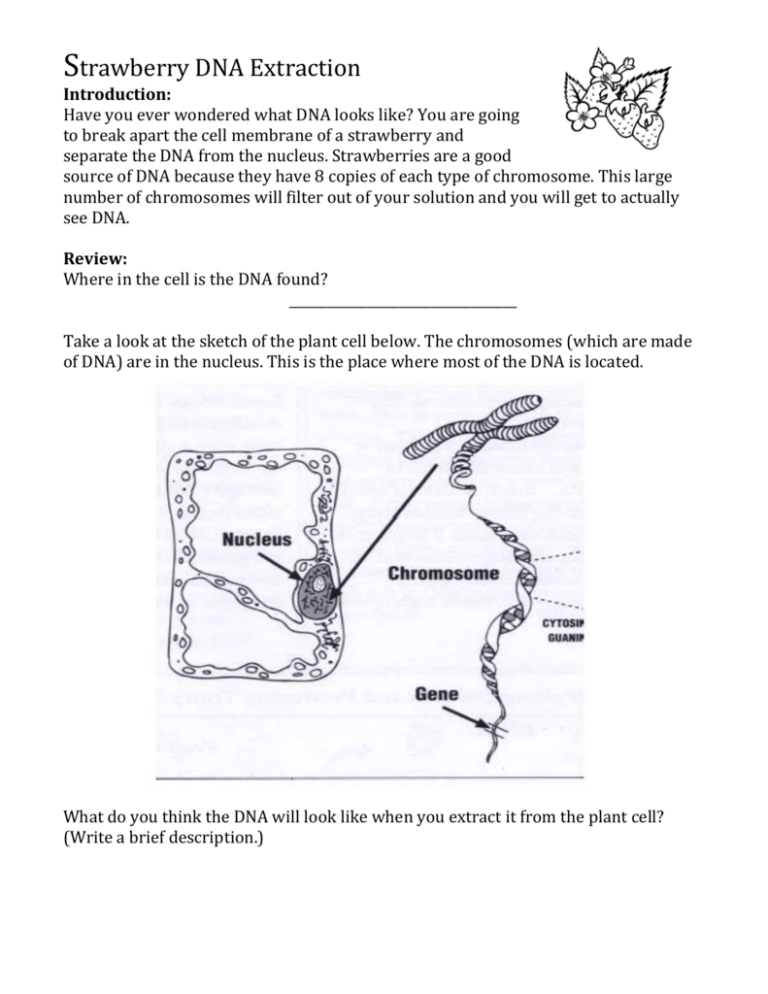
Strawberry DNA Extraction Introduction: Have you ever wondered what DNA looks like? You are going to break apart the cell membrane of a strawberry and separate the DNA from the nucleus. Strawberries are a good source of DNA because they have 8 copies of each type of chromosome. This large number of chromosomes will filter out of your solution and you will get to actually see DNA. Review: Where in the cell is the DNA found? ___________________________________ Take a look at the sketch of the plant cell below. The chromosomes (which are made of DNA) are in the nucleus. This is the place where most of the DNA is located. What do you think the DNA will look like when you extract it from the plant cell? (Write a brief description.) _______________________________________________________________ DNA Extraction from Strawberries Materials: Lab box contents: 1 Zip-type, freezer bag (6”x 9”) 1 Coffee filter, cone-shaped, #2 size 1 Plastic cup, 5 oz. 1 Plastic pipette Available from your teacher: 1 Strawberry 10 mLs DNA extraction buffer (soapy, salty water) 15 mLs ice cold ethanol in test tube Procedure: Working together in groups of two, read through the entire procedure and follow the steps in Parts I, II and III. Part I- Preparing the DNA extract 1. Have one partner get the lab box while the other partner gets the strawberry and removes the stem and leaves. 2. Place one strawberry in a zipper bag. 3. Mash up the strawberry for 2 minutes. 4. Add 10 mLs of the extraction buffer to the bag. 5. Mash again for 1 minute. While one partner is mashing the other partner must do step 6. 6. Drape the coffee filter in the cup. Make sure the top part of the filter is folded over the top of your cup and that the bottom of the filter does not touch the bottom of the cup. 7. Pour the mashed strawberries with the extraction buffer into the filter and let drip into the bottom of the cup. This takes about 10 minutes. As you wait for your solution to filter, complete the following questions: Part I: Questions a. What was the purpose of mashing up the strawberry? _________________________________________________________________________ b. What does the extraction buffer do? (Hint: Extraction buffer contains soap. What does soap do when you wash your hands?) _________________________________________________________________________ c. What does the filter do? _________________________________________________________________________ Part II: Pipetting the strawberry extract into the alcohol 8. One partner gets a test tube that contains ice cold ethanol. 9. Using a pipette, remove some of the strawberry extract from the cup. Carefully pipette the strawberry extract into the alcohol in the test tube and watch the solution precipitate (separate). DO NOT SHAKE THE TUBE!!! Very gently swirl the tube once or twice. Then let the tube remain undisturbed. Part III: Observations 10. Watch where the alcohol and extract layers come in contact with each other. Keep the tube at eye level so you can see what is happening. What do you see appearing? (Sketch what you see in the and note any other observations.) Notes: __________________________ __________________________ Questions Parts II and III: a. What happened when you added the filtrate to the alcohol? _________________________________________________________________________ box b. What did the DNA look like? _________________________________________________________________________ 1. A person cannot see a single cotton thread four classrooms away. But if you wound thousands of threads together into a rope, it would be visible at the same distance. How is this statement an analogy to our DNA extraction? _________________________________________________________________________ _________________________________________________________________________ 2. Is DNA found in all living or once living cells? _________________________________________________________________________ 3. Since the strawberries were once living, and we extracted DNA from them, what does this mean about the foods you eat? _________________________________________________________________________ 4. Look at the plant cell pictured on page one of the lab handout. Remember that genes are found on chromosomes, and genes control traits. Give at least two examples of traits that are expressed in the strawberry. _________________________________________________________________________ _________________________________________________________________________ 5. Scientists can now change the DNA or certain organisms, giving them different traits. They can make plants that we eat more disease resistant, better tasting or more nutritious. Do you think there is any dangers in eating these foods with modified DNA?
